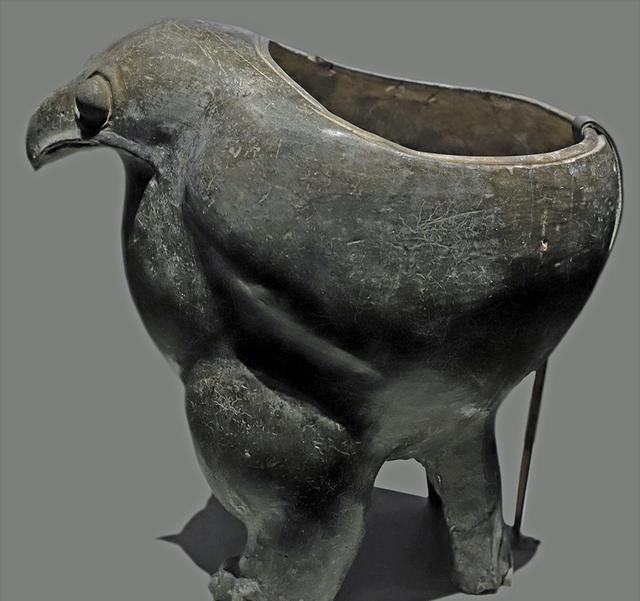In 1957, when Yin Siyi, a farmer in Shaanxi Province, was ploughing the fields, he suddenly shook his plough, dug out a strange clay pot, and took it home as a chicken food basin. A year later, experts decided whether it was a national treasure or an orphan...

How did the mediocre "chicken food bowl" in the eyes of the old farmer Yin Siyi turn into a national treasure?
Because it is the unique Tao Yingding in the Yangshao cultural relics dating back about 5300 years. Although many pottery has been excavated in China's Neolithic Age, there is currently only one pottery in the shape of a bird.
So, why does the "national treasure of the national treasure" appear in the homes of farmers in Huaxian County, Shaanxi Province?
One day in 1957, the old farmer Yin Siyi went to plough the field, and suddenly the plough shook, as if it had hit something hard. He dug up the dirt with his hands, pulled out a jar that looked like it was made of stone, picked it up, and wiped off the thick layer of dirt on the surface. The peculiar shape of this jar immediately appeared, like a fat rooster, but without a crown, and there was a bowl on the back, which at first glance looked very cute. Yin Siyi took it home and used it as a chicken food bowl.
Unexpectedly, this "chicken food bowl" frightened the domestic chickens, and at first none of them dared to go near the food.
If on weekdays, Yin Siyi sprinkled the feed, this flock of chickens would be scrambled and clucked... Today is strange, the chicken food bowl is full of feed, but they dare not come close, they have detoured to avoid.
This made Yin Siyi wonder, staring at the chicken food bowl at his feet, feeling a little strange, just didn't see that it was an eagle!
In this way, Tao Yingding, who later became the treasure of the Seven Towns Museum of China, worked as a "chicken food bowl" in the courtyard of Yin Siyi's family for a year.
Until 1958, the Peking University archaeological team found a human site from the Yangshao culture period in Quanhu Village, Hua County, Shaanxi Province, and decided to visit and investigate nearby. When passing by Yin Siyi's house, the chicken food bowl in the courtyard attracted archaeologists, because the shape was so novel.
After careful observation, experts preliminarily speculated that this basin is most likely related to the Yangshao cultural site in Quanhu Village. Therefore, the expert borrowed a chicken food bowl from Yin Siyi and brought it back to the laboratory for identification.
When the specialist was in the laboratory, after cleaning the basin, he froze. This is a fat rooster, which is clearly a hunting eagle.
This eagle is 35.8 cm tall, 23.3 cm in diameter, and has a maximum abdominal diameter of 32 cm, the eagle is strong, the legs are thick, the wings are attached to the sides of the body, and the standing bracket is like a tail hanging to the ground, forming a three-legged position with the eagle's legs. The bulging eagle eyes, the curved hooked beak, and the mouth are set between the back and the wings, resembling a back hug, looking fierce and cute.
This shape is different from other pottery of the same period, and it appears in a three-dimensional shape, as if it were alive.
Deeply surprised, the archaeological team quickly found Yin Siyi, hoping to locate the excavation location of Tao Yingding through his guidance, and then organize excavation. And this excavation finally revealed the true identity of the "chicken food bowl", shocking the entire archaeological community.
It turned out that the basin was unearthed from a tomb and pressed under the feet of a female tomb owner of thirty or forty years old. At the same time, more than a dozen bone daggers, stone axes, stone guis and a batch of living utensils were unearthed... After research, experts determined that they were all relics from the late Neolithic period.
Due to the large area around it, no other tombs have been excavated, and the identity of the owner of this tomb cannot be confirmed.
But the only thing that can be confirmed is that the chicken food bowl is a bird-shaped pottery from the Neolithic period, with rare shape, immeasurable historical and artistic value, and named it: Tao Yingzun.
After the old farmer Yin Siyi learned that his "chicken food bowl" was a priceless treasure, he did not take it for himself, but decided to hand it over to the state free of charge.
In this way, Tao Yingzun was successfully collected in the National Museum of China. Because its value is constantly being excavated, famous archaeologists evaluate it: this cultural relic has opened a precedent for the shape of pottery birds and beasts. After that, it was rated as a national first-class cultural relic and renamed "Tao Ying Ding".
In 1993, when Beijing bid for the 2000 Olympic Games, the lovely Tao Yingding represented the 5,000-year-old civilization of China and went to the Olympic Museum in Switzerland to exhibit, becoming one of China's national treasures "Olympic Bid Ambassadors".
Later, in 2002, Tao Yingding was included in the "Catalogue of Cultural Relics Banned from Going Abroad (Border) exhibitions" by the State Administration of Cultural Heritage, and together with two well-known heavyweight cultural relics, Houmu Pengding and Zeng Houyi Chimes, it became one of the 64 national treasure cultural relics that were permanently banned from going abroad, which shows its high status.
At the same time, I have to sigh that the imagination and production level of Chinese craftsmen more than 5,000 years ago were so high!
Source: Tao Yingding - Intoxicated for Six Thousand Years" documentary. Central Radio and Television Corporation, State Administration of Cultural Heritage